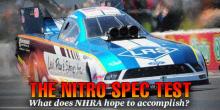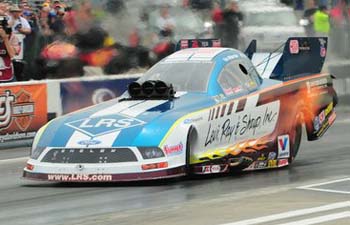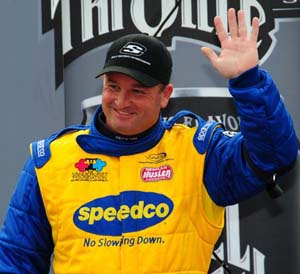NITRO SPEC TESTING: WHAT DOES THE NHRA HOPE TO ACCOMPLISH?
 upcoming nitro engine spec tests is the first step in that direction.
upcoming nitro engine spec tests is the first step in that direction.The first test, to be conducted by the NHRA technical department, will take place following the Thunder Valley Nationals at Bristol Dragway.
However, a thunderous roar has been filling the NHRA’s nitro garage since the specifications for a new drive train package were issued two weeks ago to the PRO membership. NHRA officials have tried to let the membership know that their efforts are merely a data-gathering practice, a move which hasn't stopped many racers from getting up in arms over the notion the proposed specs could become written in proverbial stone.
NHRA Says Test Is One of Many To Come …
While the NHRA has no timetable for a return to quarter-mile racing in their professional nitro divisions, officials believe a series of  upcoming nitro engine spec tests is the first step in that direction.
upcoming nitro engine spec tests is the first step in that direction.
The first test, to be conducted by the NHRA technical department, will take place following the Thunder Valley Nationals at Bristol Dragway.
However, a thunderous roar has been filling the NHRA’s nitro garage since the specifications for a new drive train package were issued two weeks ago to the PRO membership. NHRA officials have tried to let the membership know that their efforts are merely a data-gathering practice, a move which hasn't stopped many racers from getting up in arms over the notion the proposed specs could become written in proverbial stone.
“There is nothing for people to be concerned over, we are just testing and researching,” said NHRA VP of Technical Operations Glenn Gray. “We need to learn some things. As a sanctioning body, we need to be doing these types of things to learn more about this.
“It's just data collecting and for one thing we've said that when we do all this research all the data we collect will be shared with all the teams so they'll know what was done, how it was done and what we learned.”
“We don't know which direction this is going, so we look at this as a place to start,” Gray added.
According to the Gray, this first test, to be conducted in cooperation with Tim Wilkerson, is a part of the data gathering process aimed at expanding the sanctioning body’s understanding of what is possible with different nitro configurations. Funding for the test is coming from the NHRA, not PRO or any of the race teams.
The NHRA will begin with the following combination:
1.) 4.187 Bore
2.) 3.750 Stroke
3.) 7 to 1 Compression
4.) Single 70-gallon fuel pump
5.) 15% overdrive on the blower
6.) Timing management as is
7.) 350 rear end gear
8.) 90% Nitro Methane limit
9.) No rev-limiter
There is nothing for people to be concerned over, we are just testing and researching. - NHRA VP OF TECHNICAL OPERATIONS - GLENN GRAY
a d v e r t i s e m e n t
Click to visit our sponsor's website

Team owner Bob Vandergriff Jr. commends the NHRA on these steps to rectify the situation. However, he believes the sanctioning body should have had the foresight nine years ago to start addressing the issues. The chairman for the NHRA Driver’s Committee believes the current headaches could have been averted.
Nine years ago, Vandergriff says, is when nitro racing began to travel down an expensive path of trying to govern itself. The NHRA began policing nitro percentage and other areas following a catastrophic engine explosion on Doug Herbert's dragster at the end of the 1999 season.
“I think the test is interesting,” Vandergriff told CompetitionPlus.com. “I can understand the argument from both sides. As a racer your first thought is to be against it, which I have heard from the majority. But as a business person who is constantly trying to sell our sport and bring new companies into it I can see the rationale.”
“I think the root of the complaining comes from the lack of addressing the issue when it needed to be addressed; being proactive instead of reactive,” Vandergriff explained. “We have seen a rule instituting a nitro percentage reduction which was then overcome by increasing fuel volume, spinning the blowers faster, increasing the compression to introducing the rev limiter to fix the first rule that was easily bypassed by the above compensations.
"Nobody likes to change stuff or spend money on a rule that ends up being useless.”
While the NHRA insists the tests are strictly data gathering exercises which may or may not result in eventual changes to the rulebook, there are those who believe the exercise is an effort to appease insurance companies, who reportedly have told the NHRA slow down the race cars or else.
How many tests will there be before, or if, a decision is handed down? No one knows, including the NHRA.
“I don't even want to put a number on it because we're going to go down this path and learn what we learn,” Gray explained. “It's going to take time and we know that. We haven't put a limit on how long we're going to test or how long we're going to do this research. We're not putting any pressure on ourselves right now in regards to that. It's strictly a research project right now.”
Likewise there’s no rush to return to the quarter-mile race course either. However, Gray did say that there is one definite parameter to the testing – 300 mph. The NHRA is not looking to slow down the nitro cars below the 300 mile per hour mark.
a d v e r t i s e m e n t
Click to visit our sponsor's website

Team owner and driver Morgan Lucas admits his feelings wouldn’t be hurt in the least if the NHRA chooses to remain at 1,000 feet.
“I think 1,000 foot racing is growing on people,” Lucas said. “The costs are coming down and it’s fun again. The racing is tighter again. Nitro races are coming down to the thousandths – that’s close racing. In my opinion, that’s the way the sport should be. This sport should was built on innovation and should stay that way.”
Vandergriff has long believed the quarter-mile drag strip improves the chances to sell drag racing to a potential sponsor. His opinion has been – reduce the horsepower, slow the speeds naturally.
Vandergriff wonders if nitro racing really needs 8,000-horse engines, which doubles the output of the injected nitro cars in the Top Alcohol Dragster division. The A/Fuel Dragsters have been as quick as a 5.103 elapsed time at 284.75 miles per hour.
“One question I have had is if an A Fuel car can run 5-teens at close to 280 mph with no management and roughly say 4000 horsepower … then I’m pretty sure they would run 4.90’s at close to or over 300 mph with management,” said Vandergriff. “My question then becomes does it take twice as much power to run four or five tenths quicker and 30 mph more? I think if we could reduce the power we could accomplish two things and appease both sides of the argument.”
Then there’s the concern if the NHRA slows the cars too much the Top Fuel cars could overlap the A/Fuel Dragsters.
Gray told CompetitionPlus.com that won’t happen.
“No, we're not going to go that far,” Gray said. “If we did that then we would obviously found that out from that combination. If we saw speeds like that then okay 'we went too far' and we would have to go back in the other direction. We only intend just to take a little bit of speed off, not very much. We're trying to reduce catastrophic engine failure and trying to limit the effects of what happens when these things fail.”
a d v e r t i s e m e n t
Click to visit our sponsor's website
There are numerous suggestions floating around the community ranging from a narrower tire to a suggestion that monitoring

Jim Oberhofer, a respected crew chief for the Kalitta Motorsports team, wonders if all the expenditure of money and effort, are really worth devaluing the product in the long run to the point fans lose interest in drag racing, just for the sake of returning to the quarter-mile.
“If the fans want to see Top Fuel cars that are going to run 4.90s at 290 miles per hour [for the sake of going quarter-mile racing] … well that’s … great. I just can’t believe that’s what they want to see,” Oberhofer said, regret permeating his voice.
Oberhofer’s stance hasn’t wavered in the least in believing the unsafe tracks should bear the brunt of the financial responsibility instead of the teams and the sanctioning body.
Some tracks have stepped up, such as the NHRA-owned facilities in Indianapolis, Pomona and Atlanta with the new engineered sand-traps and catch nets. Facilities such as Gateway International Raceway (St. Louis), zMax Dragway (Charlotte, N.C.) and Bandimere Speedway (Denver, CO.) have stepped up with similar containment devices in the shutdown area.
“The first thing that needs to be addressed are the race tracks,” Oberhofer explained. “If you’re going 320 at the 1,000 foot … that means at the quarter-mile you may be going 270 miles per hour at the quarter-mile mark with the parachutes out and on the brakes. By slowing these cars down to 300 in the quarter-mile I think you’ve made it worse.”
He cites Scott Kalitta’s Englishtown incident as the perfect example.
“Scott’s car wasn’t running that great and he was running 300 miles per hour in the quarter-mile,” Oberhofer said. “What killed Scott was the race track. It was the insufficient sand-trap. It was the insufficient netting and then it was the boom truck. I don’t think the reason we don’t have as many fans this year is not because we are running 1,000 foot. It’s because people don’t have money.”
“Look at those ADRL races like the one they had in Houston. That place was packed because the tickets were free. At the end of the day it boils down to they came and watched eighth mile drag racing.”
a d v e r t i s e m e n t
Click to visit our sponsor's website
Team owner Don Schumacher is one of those who doubts the combination the NHRA is starting with is the right one.
“I believe it is way too drastic of a move,” Schumacher said of the initial proposed specs. “The cars would be performing like nostalgia Funny Cars and dragsters perform. I find it hard to believe that fans will come out for 250 mile per hour cars.
“For the NHRA to be spending the kind of funds they must be spending to be running this kind of test really surprises me in this economic climate,” Schumacher said. “What is the long term plan?”
The NHRA has a long term plan according to Gray, and the long terms plan begins with Wilkerson’s test. Details beyond the first test were not revealed.
So how did the NHRA end up settling on Wilkerson to conduct their research?
According to Gray, finding a team willing to convert their car away from the current combination to test for the NHRA didn’t exactly draw an overwhelming pool of volunteers.
“Well, I think we were probably lucky,” Gray said, of the NHRA’s ability to work with Wilkerson. “We've been struggling a little bit to find people that wanted to work with us. Obviously, it takes away from the other things people are trying to accomplish during the race season. They don't want to be distracted by something like this. Tim is a good guy to work with [and] he knows how to make his car run. He is well liked. He's been very helpful to us so far and I think he will be in the future, too.”
In the end, it was Cruz Pedregon who summed up the nitro spec testing the best.
“They [NHRA] aren’t going to appease everybody,” Pedregon said. “When the NHRA makes the final decision as to where they are going to go, you are going to have your group that favors it and another group who opposes it because it doesn’t match the vision they had for it.”
Pedregon said he has a plan that is quickly adaptable and largely inexpensive but declined to discuss it on the record before making a presentation to the NHRA.
“They [NHRA] have to make the best decision they can based on the data they have at hand,” Pedregon continued. “I think in the long run the NHRA will do the right thing. Remember we had a lot of people crying about the countdown and when they ended up in one of those eight spots – it was fine with them then.”
| {loadposition feedback} |






